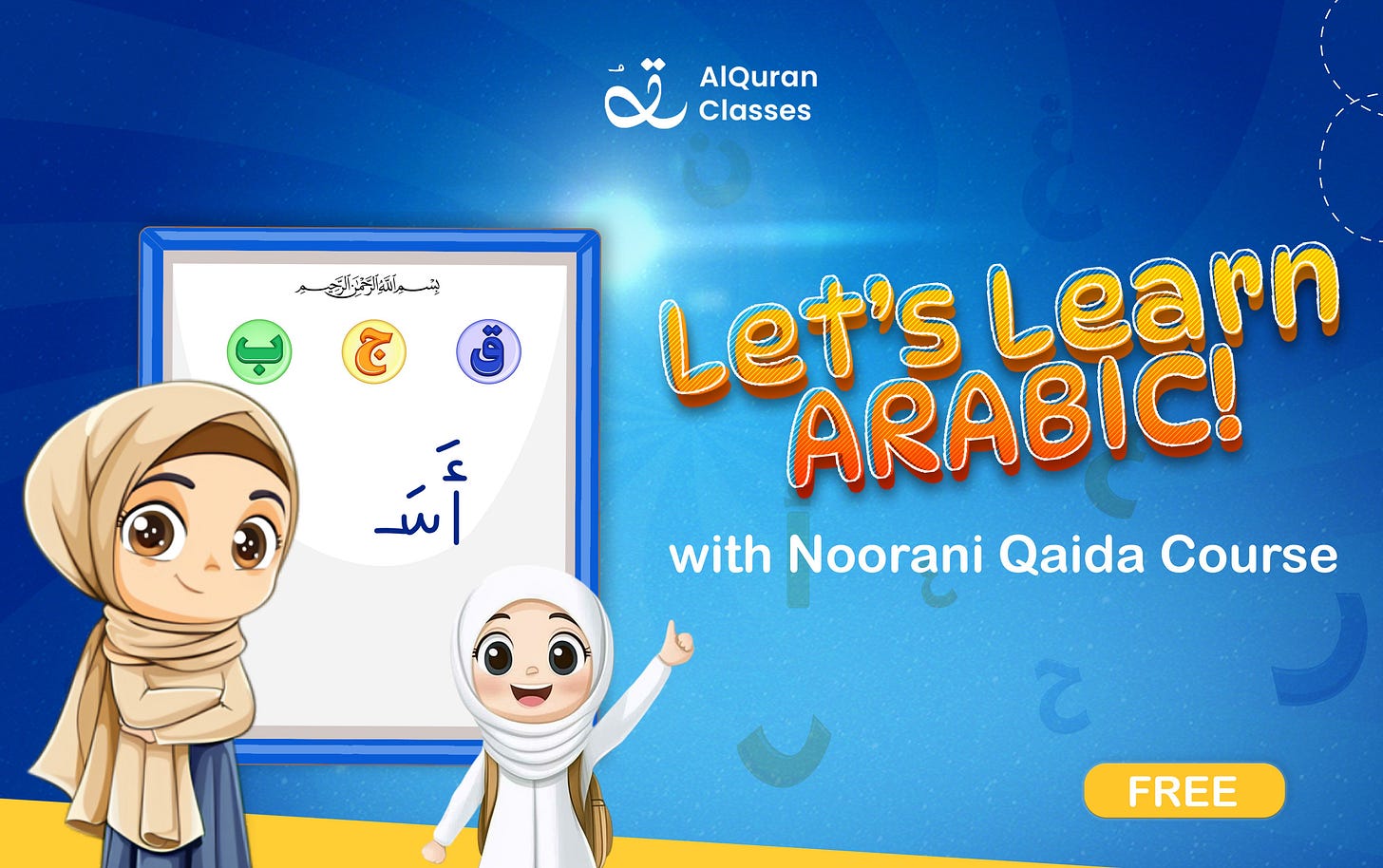Bayt Al-Quran: Noorani Qaida-Course Benefits
The Game-Changer in Early Quran Learning for Kids
Hey Muslim Mama & Baba
Have you ever wondered how your child can develop a strong foundation in Quranic recitation? The answer lies in Noorani Qaida—a structured and scientifically designed course that serves as the first step in learning how to read the Quran properly. Noorani Qaida is not just an introduction to Arabic letters; it is a comprehensive guide that ensures your child builds the essential skills required for correct Quranic recitation with Tajweed.
Why Noorani Qaida is Essential for Your Child’s Learning
Before diving into Tajweed rules and fluent recitation, every child must first develop a strong grasp of the fundamental elements of Arabic phonetics. Noorani Qaida provides a step-by-step approach, ensuring that your child:
Learns each Arabic letter, its correct pronunciation, and the sounds it makes in different word placements.
Understands the structure and forms of Arabic letters, whether they appear at the beginning, middle, or end of a word.
Develops confidence in reading Arabic fluently, paving the way for advanced Quranic studies.
By starting with Noorani Qaida, children acquire a solid linguistic foundation that eliminates common recitation mistakes and makes learning the Quran easier and more effective.
What Your Child Will Learn in the Noorani Qaida Course
This course covers all the crucial aspects of Arabic phonetics and Quranic pronunciation, ensuring that children gain mastery over the following elements:
1. Arabic Letters & Their Pronunciation
Your child will learn the correct articulation of each Arabic letter along with its pronunciation rules. Arabic is a phonetic language, meaning the way a letter is pronounced plays a crucial role in understanding its meaning and context.
2. Letter Forms in Different Positions
Unlike English, Arabic letters change their shapes depending on where they appear in a word. This course will teach your child how to recognize and differentiate letters in their:
Isolated form (when standing alone)
Beginning form (when appearing at the start of a word)
Middle form (when appearing in the middle of a word)
End form (when appearing at the end of a word)
3. Comparing Letter Sounds & Similar Pronunciations
Some Arabic letters look similar but have distinct sounds. Noorani Qaida teaches children how to differentiate these subtle pronunciation differences, which are essential for correct Quranic recitation.
4. Qalqalah Letters
Your child will learn about the special echoing effect in Arabic, called Qalqalah (bouncing sound), which occurs when specific letters (ق، ط، ب، ج، د) carry sukoon. Mastering this helps improve fluency and articulation.
5. Saakinah Letters & Sukoon Rules
Understanding sakinah letters (letters with sukoon) is a key element in fluent recitation. This course will help children grasp how sukoon affects pronunciation and how to pause correctly when reading the Quran.
6. Different Forms of Hamza
Hamza (ء) is a unique Arabic letter that appears in different shapes and positions. Noorani Qaida teaches kids the correct way to pronounce and read hamza in different contexts.
7. Tanween & Shaddah
Tanween: Understanding the double vowel sounds (ً ٍ ٌ) that add fluency to recitation.
Shaddah: Learning the emphasis ( ّ ) placed on certain letters, which strengthens articulation and clarity in recitation.
8. Levels of Pronunciation (Martabaa)
Children will be introduced to Martabaa, which refers to the different levels of sound articulation used when reciting the Quran. This ensures they develop a rhythmic and fluent recitation style.
9. Dua Memorization
At the end of each class, children will also learn a new dua, helping them build a habit of daily supplication alongside their Quranic studies.
Why Noorani Qaida Strengthens Quranic Recitation
The ability to recite the Quran correctly starts with mastering Noorani Qaida. By learning this foundational book, children not only recognize letters but also grasp the science of Arabic phonetics. This makes Tajweed (the rules of Quranic recitation) second nature for them as they progress in their learning journey.
Noorani Qaida builds accuracy, fluency, and confidence in reading Arabic. By following this structured approach, children avoid common pronunciation mistakes and develop a lifelong connection with the Quran.
The Best Way to Teach Noorani Qaida to Your Kids
Teaching Noorani Qaida requires expertise, patience, and an engaging approach to keep children interested. While many parents try to teach it at home, having qualified native Arab teachers makes the learning experience smoother and more effective. That’s where we come in!
At AlQuranClasses, we bring native Arabic-speaking teachers who specialize in making Noorani Qaida fun, interactive, and engaging for kids. Learning from a qualified instructor ensures that your child:
Pronounces Arabic letters correctly from the beginning.
Understands the science behind Quranic recitation.
Learns in an interactive and enjoyable environment that fosters confidence.
Give Your Child the Best Start in Their Quranic Journey
The foundation of a child’s Quranic education sets the stage for a lifetime of meaningful recitation and connection to the Quran. Noorani Qaida is more than just a learning tool—it is the gateway to proper pronunciation, Tajweed mastery, and a deeper appreciation for the beauty of the Quran.
Ensuring that your child learns Noorani Qaida the right way is an investment in their spiritual growth. With our expertly designed course, your child will receive guidance from native Arabic-speaking teachers who specialize in making Quranic learning both effective and enjoyable.
Our Noorani Qaida Course is launching soon, and we invite you to be a part of this journey. Secure your child’s place in a structured, engaging, and rewarding learning experience.
Subscribe now to our Substack for updates and be among the first to enroll. Give your child the opportunity to build a strong Quranic foundation from the comfort of home.
We look forward to being a part of your child’s Quranic journey.




